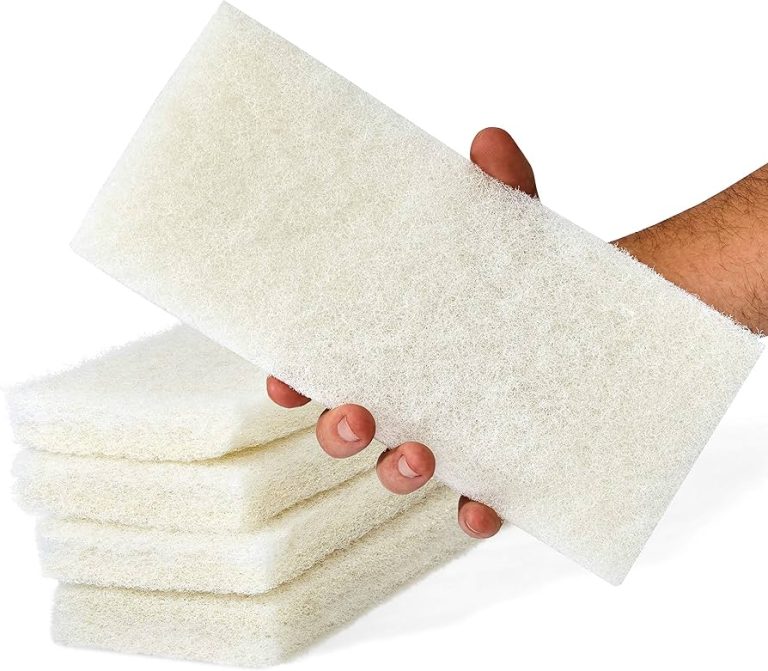Have you ever found yourself hesitating before using a scrub sponge, worried about damaging your delicate surfaces? You’re not alone.
Many people face the same dilemma, trying to balance cleanliness with care. Scrub sponges can be your best friend for tackling stubborn grime, but they can also turn into your worst enemy if not used correctly. Imagine the disappointment of discovering scratches on your favorite countertop or realizing the finish on your new appliance is dulled.
But fear not! With the right tips and tricks, you can master the art of using scrub sponges effectively and safely. This guide will reveal how you can clean smarter, protect your surfaces, and feel confident in your cleaning routine. Keep reading to discover how you can transform your cleaning strategy and ensure your surfaces stay as perfect as the day you got them.

Credit: www.walmart.com
Choosing The Right Sponge
Many scrub sponges are available. Each has a different purpose. Some are soft. Others are rough. Soft sponges are good for delicate surfaces. Rough sponges help clean tough stains. Use soft sponges for glass and wood. Use rough sponges for pots and pans. Choose the right sponge for each job. This will keep surfaces safe.
Sponges come in different materials. Natural sponges are soft and eco-friendly. Synthetic sponges last longer and clean well. Choose natural for gentle cleaning. Choose synthetic for heavy-duty tasks. Be sure to rinse after use. This keeps them clean and ready.
Sponges come in many sizes and shapes. Small sponges fit in tight spaces. Large sponges cover big areas fast. Choose small ones for corners and edges. Choose large ones for floors and walls. A right size sponge makes cleaning easy.

Credit: www.fredmeyer.com
Prepping Your Sponge For Use
Sponges can hold many germs and bacteria. Boil your sponge in hot water for 5 minutes. This kills most germs. You can also use the microwave method. Wet the sponge and heat it for 1 minute. Make sure it is wet, or it may burn. Do this every few days. It keeps the sponge clean and safe. Always let it cool before touching.
A wet sponge works best for sticky messes. It wipes them up easily. Dry sponges are great for dusting. They pick up dust without spreading it around. Always choose the right sponge type. This helps in keeping surfaces scratch-free. Replace your sponge when it smells bad. A fresh sponge works better and is safer.
Effective Cleaning Techniques
Scrub gently in a circular motion. This helps avoid scratches. Keep the pressure light. This protects the surface. Use a sponge that is slightly damp. Dry sponges can be too rough.
Focus on one spot at a time. This method cleans better. Use a corner of the sponge. It helps in reaching small areas. Move gently over the stain. Use a small amount of cleaner. Avoid using too much water.
Rinse the sponge often. This removes dirt and grime. Clean water is best for rinsing. Repeat the process if needed. Make sure the surface is clean. Dry the area after cleaning. This prevents water spots.
Protecting Different Surfaces
Scrub sponges can be too rough for delicate surfaces. Avoid using them on wooden tables or polished furniture. They may leave scratches or marks. Use a soft cloth instead. For delicate surfaces, gentle care is needed.
Hard surfaces need a different approach. Use the scrubby side of a sponge. Apply gentle pressure. Focus on the stain. Avoid harsh chemicals. Rinse the sponge often. This helps to clean better.
Glass and mirrors need gentle cleaning. Use the soft side of a sponge. This avoids streaks. Wipe in a circular motion. Dry with a clean cloth. This keeps surfaces shiny and clear.
Maintaining Your Sponge
Scrub sponges efficiently clean without harming surfaces. Gentle pressure and circular motions protect finishes. Regular rinsing keeps sponges effective and safe.
Cleaning And Disinfecting
Scrub sponges can be a great tool for cleaning. It’s important to keep them clean. Use warm water and soap to wash the sponge. Rinse it well to remove all soap. Disinfecting is crucial. Soak the sponge in vinegar for 5 minutes. You can also use a bleach solution. This kills bacteria and germs.
Proper Drying Techniques
Always dry your sponge after use. This prevents mold and bad smells. Place it in a sunny spot if possible. Air drying is best. Avoid storing it wet. Use a rack or hook. This ensures air can flow around the sponge. Keeping it dry helps it last longer.
When To Replace Your Sponge
A sponge needs replacing after 2 weeks. Check for bad smells or mold. If it smells, replace it. Signs of wear mean it’s time for a new one. A new sponge cleans better. Don’t use a worn sponge. It can damage surfaces. Replace regularly to keep cleaning safe.
Eco-friendly Sponge Options
Biodegradable sponges are great for the planet. They break down quickly after use. These sponges are made from natural materials. They are safe for surfaces and skin. You can find them in many stores. Look for sponges made from cellulose or plant fibers. These options are gentle and durable. They help keep your home clean without harm.
Dispose of old sponges carefully. Cut them into small pieces before tossing. This helps them break down faster. Composting is another option. Many biodegradable sponges are compost-friendly. Check the packaging to be sure. Recycling centers sometimes accept sponges. Call first to check their policies. Proper disposal keeps our planet healthy.
Make your own sponge at home. Use old fabric scraps. Cut them into squares or circles. Sew them together for a sturdy sponge. Old towels work well too. Washable sponges save money. They reduce waste. You can reuse them many times. Try making different sizes for different tasks. DIY sponges are fun and easy.

Credit: www.amazon.com
Frequently Asked Questions
Should You Use The Same Sponge For Dishes And Countertops?
Using the same sponge for dishes and countertops is unhygienic. Separate sponges reduce cross-contamination risk. Germs from countertops can transfer to dishes, posing health hazards. Regularly replace sponges to maintain cleanliness. Use different colors or labels to distinguish them easily.
Keep your kitchen safe by using dedicated cleaning tools.
Is It Better To Clean With A Sponge Or Cloth?
Use a sponge for scrubbing tough stains and a cloth for gentle cleaning and drying surfaces. Both tools have unique benefits. Sponges offer more scrubbing power, while cloths are great for delicate surfaces. Choose based on the cleaning task and surface material.
What Holds More Bacteria, A Sponge Or A Dishcloth?
A sponge holds more bacteria than a dishcloth. Its porous structure creates an ideal environment for bacteria growth. Regularly clean or replace your sponge to reduce bacteria buildup and maintain kitchen hygiene. Dishcloths tend to dry faster, which limits bacterial growth compared to sponges.
What Do Restaurants Use Instead Of Sponges?
Restaurants often use dish cloths or scrub brushes instead of sponges. These tools are easy to clean, reducing bacteria spread. Microfiber cloths are also popular for their effective cleaning ability. Restaurants prioritize hygiene, so they choose durable cleaning tools that can be sanitized thoroughly.
Conclusion
Scrub sponges can clean effectively without causing damage. Use the right sponge for each surface. Test on small areas first. Avoid using harsh chemicals that can harm surfaces. Keep sponges clean to prevent spreading dirt or bacteria. Store sponges in a dry place to extend their life.
Choose eco-friendly options for a sustainable choice. Follow these tips to ensure surfaces remain in great condition. Cleaning should be safe and effective. Protect your surfaces with the right care. Happy cleaning!


